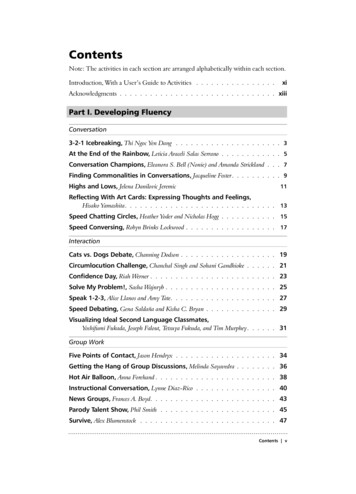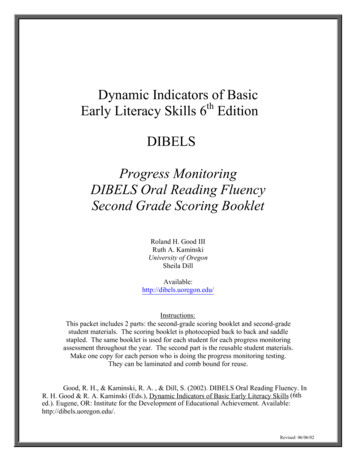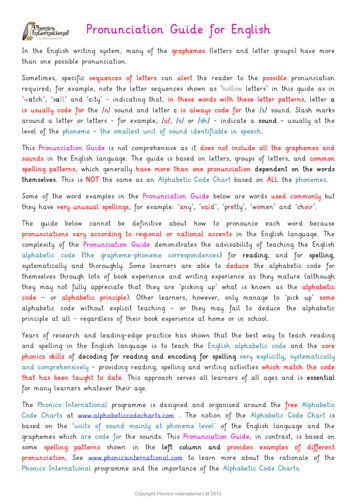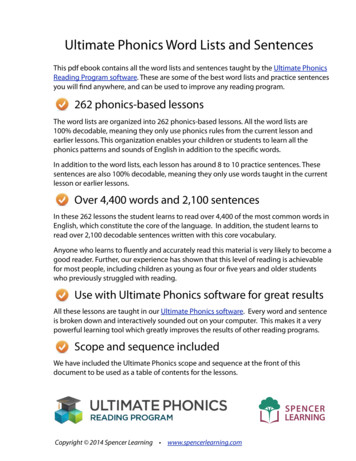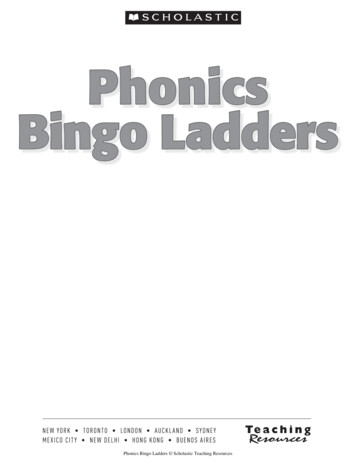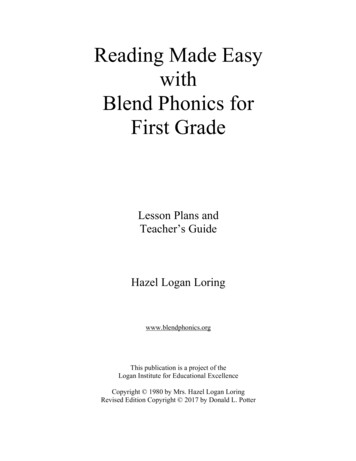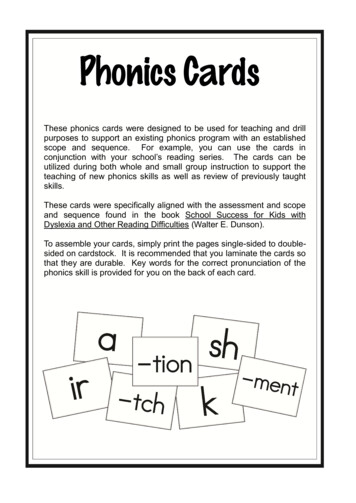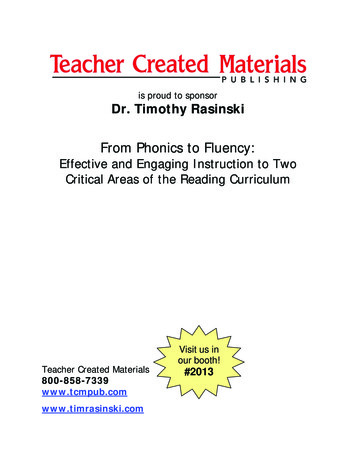
Transcription
is proud to sponsorDr. Timothy RasinskiFrom Phonics to Fluency:Effective and Engaging Instruction to TwoCritical Areas of the Reading CurriculumTeacher Created .comVisit us inour booth!#2013
You can download a copy of today’s presentation handout at:www.timrasinski.comWhere you will also find: Links to Dr. Rasinski’s published research Calendar of speaking engagements Online store where you can purchase his authored materialsNewAnnouncing TCM PodcastsTeacher Created Materials’ podcasts are a great way for you to stayup-to-date on educational topics. Each episode will inspire you andprovide useful information you can take into your classroom.The first three episodes will feature Dr. Timothy Rasinski!Episode 1Episode 2Episode 3-“Fluency 101: Accuracy, Automaticity, and Expression”“Practice, Practice, Practice”“Making and Writing Words & Building Vocabulary”Subscribe to our feed athttp://www.tcmpub.com/podcastsYou can listen now, or download for later!Free!1
Effective Teaching of Reading: From Phonics to FluencyTimothy RasinskiKent State University402 White HallKent, OH 44242330-672-0649, trasinsk@kent.eduThe Bridge from Phonics to Comprehension:Three Components of Fluency1. Accuracy in word recognition (word decoding).Approximately 95% word recognition accuracy is considered adequate forinstructional level reading.2. Automaticity in word recognition.Readers not only are accurate in word recognition, they are effortless orautomatic in recognizing the words they encounter. The significance ofachieving automaticity is that readers can devote their limited cognitiveresources to the important task of comprehending the text.Automaticity is most often assessed by determining a reader’s readingrate on a grade level passage in words correct per minute. Since rateincreases as readers mature, no one rate is considered appropriate. Youwill need to check students’ rate against the table of grade level norms.3. Interpretive and meaningful reading.Readers use their new-found cognitive “energy” to interpret the passagethey are reading. In oral reading this is done through an expressive andappropriately phrased rendering of a written passage at an appropriatelyfluent speed. It is assumed that this type of interpretive reading is alsoreflected in silent reading.Interpretive and meaningful reading is best measured through a qualitativerubric in which the teacher listens to a reader read grade level materialand rates the reading according to descriptions provided in the rubric.Readers who fall in the lower half of most are normally considered lessthan minimally adequate or proficient in fluency.2
Components of Effective Fluency InstructionFluency is the ability to read accurately, quickly, expressively, with good phrasing, AND withgood comprehension.A recent study sponsored by the U.S. Department of Education found that fourth gradestudents’ oral reading fluency is a strong predictor of silent reading comprehension. Moreover,the same study found that nearly half of the fourth graders studied had not achieved even aminimally acceptable level of reading fluency. Fortunately, a solid body of evidence suggeststhat fluency can be taught and that effective instruction in fluency leads to overallimprovements in reading. Accuracy in Word Recognition Model Fluent Expressive Oral Reading for Students Repeated (Practiced) Reading of Authentic Textso Performance – Poetry, Scripts (Readers Theater), etc. Assisted (Scaffolded) Reading Focus on Phrased Reading Be Sensitive to Text Difficulty. Create Synergistic Instructional RoutineFor more on fluency, see the chapter on fluency from the Report of the National Reading Panel.See also, Technical Report 2-008 from the Center for the Improvement of Early Reading ml).3
Fluency Accuracy and Automaticity: Assessment and NormsACCURACY:Calculation: Total number of words read correct divided by Total words read (correct orcorrected uncorrected errors). Example: 137 words read correct / 145 total words read(137 correct 8 uncorrected errors) 94.5% correct.Interpretation:99% Correct: Independent Level Reading95% Correct: Instructional Level Reading90% Correct: Frustration Level ReadingAUTOMATICITY:GradeFallWinterSpring152550-60 1286115132135-1457147158157-1678156167166-171* words correct per minuteProcedure: Ask the student to read orally for one minute from grade-level curriculum material.Ask him to read in his normal manner, not overly fast or slow.Administer reading probes at least three times per year.Scoring of wcpm: Count the number of words read correctly in one minute (Include errors corrected)Analysis and Interpretation: Students reading significantly below the stated norms (20% ormore below norms) are at risk in reading decoding and/or fluency, and should be consideredfor further assessment and diagnosis.Adapted from: Hasbrouck, J. E. & Tindal, G. (1992). Curriculum-based oral reading fluency forms for students in Grades2 through 5. Teaching Exceptional Children, (Spring), 41-44. and Howe, K. B. & Shinn, M. M. (2001). Standard readingassessment passages (RAPS) for use in general outcome measurements: A manual describing development andtechnical features. Eden Prairie, MN: Edformations.4
NAEP Oral Reading Fluency Scale4Reads primarily in larger, meaningful phrase groups. Although someregressions, repetitions, and deviations from the text may be present, these donot appear to detract from the overall structure of the story. Preservation of theauthor’s syntax is consistent. Some or most of the story is read with expressiveinterpretation. Reads at an appropriate rate.3Reads primarily in three- and four-word phrase groups. Some smallergroupings may be present. However, the majority of phrasing seems appropriateand preserves the syntax of the author. Little or no expressive interpretation ispresent. Reader attempts to read expressively and some of the story is read withexpression. Generally reads at an appropriate rate.2Reads primarily in two-word phrase groups with some three- and four-wordgroupings. Some word-by-word reading may be present. Word groupings mayseem awkward and unrelated to the larger context of the sentence or passage. Asmall portion of the text is read with expressive interpretation. Reads significantsections of the text excessively slow or fast.1Reads primarily word-by-word. Occasional two-word or three-word phrasesmay occur – but these are infrequent and/or they do not preserve meaningfulsyntax. Lacks expressive interpretation. Reads text excessively slow.A score of 1 should also be given to a student who reads with excessive speed,ignoring punctuation and other phrase boundaries, and reads with little or noexpression.5
Making & Writing T-1T-2T-3T-4T-5T-6Fr. Rasinski, T. (1999). Making and writing words. Reading Online. Available rmission to photocopy for educational use is granted.6
Making & Writing T-1T-2T-3T-4T-5T-6Fr. Rasinski, T. (1999). Making and writing words. Reading Online. Available rmission to photocopy for educational use is granted.7
DiphthongsLesson 16ow (Long o)VowelConsonantsobfghklnrstwWords and Sentences1. lowThe plane flew low over the ground.2. growPlants need water and air to grow.3. blowOn your birthday, did you blow out the candles?4. knowDo you know division and multiplication?5. grownWhat will you be when you are all grown up?6. flownBy the time we got to Hawaii, we had flown for threehours.7. blownMany trees were blown down in the storm.8. shownYou have shown so much progress in your spelling.9. thrownThe baseball player was thrown out at second base.10. growthWhen you are about 21, you will reach the end of yourgrowth.Challenge WordsstowflowslowedPhonetic Sentence for Dictation and DecodingBefore the trees were blown, they had shown a lot of growth.Word SortsVerbsNounsRhyming WordsConsonant Blend WordsWord BuildingBrainstorm and write more words that belong to this word family:ow (bow, row, tow, mow)Brainstorm words that can belong to both ow families:bow, mow, row, sow#10124 Making and Writing Words—2–3428 Shell Educational Publishing
NameLesson Challenge WordsC1.C2.C3.9 Shell Educational Publishing43#10124 Making and Writing Words—2–3
Letter (Word) ackrocklockwalkfirstrunlastFor Anagrams: Go to www.wordsmith.org/anagram. Select the “advanced” setting, then select “Printcandidate words only”. See also www.wordles.com (words in words) and www.scrabble.com.For Making and Writing Words articles by Tim Rasinski: Go to www.readingonline.org. Search in“articles” under Rasinski, or search for the articles Making and Writing Words and Making and WritingWords Using Letter Patterns.For additional resources on Making and Writing Words: Go to www.seppub.com . Search forTimothy Rasinski and Roger Heym, or for Making & Writing Words.For more on Word Ladders see: Scholastic, (Tel: 800-242-7737, choose option #3)Daily Word Ladders for Teaching phonics and vocabulary, Gr 2-3Daily Word Ladders for Teaching phonics and vocabulary, Gr 4 10
Paired Reading: HOW TO DO ITReading Together1.Both you and your child read the words out loud together. Read at the child’sspeed. You are modeling good reading for your child.2.As you read together, read every word. To make sure your childis looking at the words, one of you points to the word you arereading with a finger or card. It’s best if your child do the pointing.3.When a word is read incorrectly, you say the word correctly, and then have yourchild immediately repeat the word.4.Show interest in the book your child has chosen. Talk about the pictures. Talkabout what’s in the book as you go through it. It is best if you talk at the end of apage or section, or your child might lose track of the story. Ask what things mighthappen next. Listen to your child – don’t do all the talking.Time1.Try very hard to do Paired Reading every day for 5 minutes. If your child wantsto read longer, a total of 15 minutes is long enough.2.Select a time that is good for both you and your child. Don’t make him do PairedReading when he really wants to do something else.3.For days when you are not available, train someone else to be a substitute.Grandparents, older brothers and sisters, aunts, and baby-sitters can beexcellent reading role models, too.Place1.Find a place that’s quiet. Children are easily distracted by noise. Turn off theT.V., radio, and stereo.2.Find a place that is private. No one else should be in the room. Many familiesfind this a great opportunity for one parent to spend time with just one child.3.Find a place that is comfortable so both of you can concentrate on the storywithout having to shift around. This will associate warm and snuggly feelingswith reading.11
PAIRED READING: HOW TO DO IT (con’t)Reading Alone1.When you are reading together, allow your child to read alone when he feelsconfident and wants to. Agree on a way for him/her to signal you to stop readingalong. This could be a knock, squeeze, or tap with the elbow. (Saying “be quiet”or similar words might make your child lose track of the meaning of the story.)When signaled, you immediately stop reading aloud and feel glad that your childwants to be an independent reader.2.When your child comes to an unknown word, wait five seconds to allow time forhim to use word attack skills. If he reads the word correctly, praise theaccomplishment. However, if your child is unable to work it out after fiveseconds, you say the correct word. Then the child repeats the word and both ofyou read together out loud until the next signal to read alone.If your child misreads a word, you say the word correctly and have him repeat theword correctly. Then continue with both of you reading out loud together until thechild signals again.3.You may not be able to finish a book or chapter in one sitting. When you startthe next day, briefly discuss what happened so far in the story and start readingwhere you left off.4.If you finish a book before the end of the time, read the book again. Repeatedreading is very good practice. It builds confidence and comprehension.5.If the book has not been completed by the end of the week, it’s O.K. The child isnot expected to read every book alone. The focus of Paired Reading isenjoyment of reading together.Points to Remember PointingPacingDiscussionWaiting 5 secondsChild repeating words correctlySignaling to read alonePraising12
Tape-Assisted ReadingEvidence-Based Instruction for Improving Reading Fluency and Overall Reading ProficiencyReading research indicates that oral-assisted reading techniques, reading while listening to a fluentreading of the same text by another reading, can lead to extraordinary gains in reading fluency andoverall reading achievement. (Kuhn & Stahl, 2001; Topping, 1995).Taped-Assisted reading is a version of oral-assisted reading in which readers listen to a fluent renderingof the passage while reading it themselves. This approach to reading has a rich history and has beenshown to be especially effective with students experiencing severe difficulties in learning to read (e.g.Carbo, 1978a, 1978b, 1981; Chomsky, 1976). More recent international research has affirmed theeffectiveness of tape-assisted reading to improve students’ fluency and general rea
2. As you read together, read every word. To make sure your child is looking at the words, one of you points to the word you are reading with a finger or card. It’s best if your child do the pointing. 3. When a word is read incorrectly, you say the word correctly, and then have your child immediately repeat the word. 4. Show interest in the book your child has chosen. Talk about the pictures. Talk
